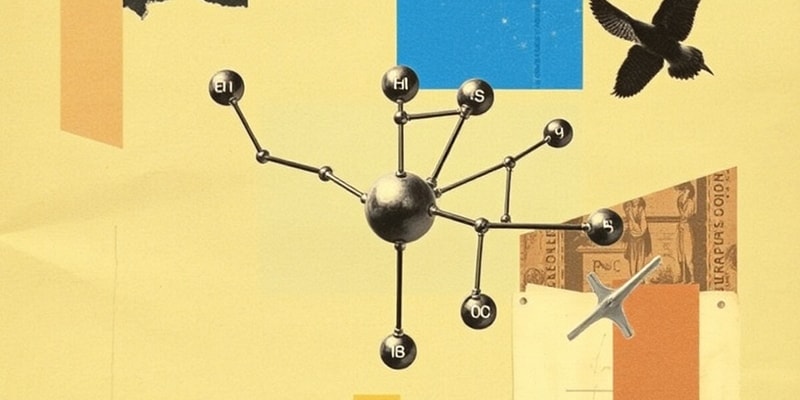Podcast
Questions and Answers
The bond angle in an H2O molecule is approximately ______ degrees.
The bond angle in an H2O molecule is approximately ______ degrees.
104.5
The theory that explains the arrangement of electron pairs around a central atom is called ______.
The theory that explains the arrangement of electron pairs around a central atom is called ______.
VSEPR
In a linear molecular shape, the arrangement is described as ______.
In a linear molecular shape, the arrangement is described as ______.
AB2
Beryllium chloride has a molecular shape classified as ______.
Beryllium chloride has a molecular shape classified as ______.
Signup and view all the answers
BF3 is classified under the molecular shape ______, which has three bonds around the central atom.
BF3 is classified under the molecular shape ______, which has three bonds around the central atom.
Signup and view all the answers
The molecular shape of sulfur dioxide (SO2) is described as ______.
The molecular shape of sulfur dioxide (SO2) is described as ______.
Signup and view all the answers
A ______ pyramid shape occurs when there is one lone pair and three bonding pairs around the central atom.
A ______ pyramid shape occurs when there is one lone pair and three bonding pairs around the central atom.
Signup and view all the answers
The molecular formula for trigonal pyramidal structures often includes a central atom labeled as ______.
The molecular formula for trigonal pyramidal structures often includes a central atom labeled as ______.
Signup and view all the answers
A square pyramid shape is analogous to ______, a famous historical monument in Egypt.
A square pyramid shape is analogous to ______, a famous historical monument in Egypt.
Signup and view all the answers
Electron pairs in VSEPR theory will take positions as far from one another as possible due to ______.
Electron pairs in VSEPR theory will take positions as far from one another as possible due to ______.
Signup and view all the answers
Study Notes
Molecular Shape
- The bond angle in an A-B-C molecule is the angle between the A-B and B-C bonds. The bond angle in water is 104.5 degrees.
- The Valence Shell Electron Pair Repulsion (VSEPR) theory states that electron pairs repel each other, causing them to take up positions as far apart as possible. This includes both lone pairs and bonding pairs.
AB2 (Linear) Shape
- Beryllium chloride (BeCl2) has a linear shape.
- Ethyne (C2H2) also has a linear shape.
AB3 (Trigonal Planar) Shape
- Boron trifluoride (BF3) has a trigonal planar shape.
- Tavaborole contains a boron atom with three surrounding atoms, making it a trigonal planar structure.
AB2E (Angular, Bent) Shape
- Sulfur dioxide (SO2) has an angular or bent shape.
Trigonal Pyramid Shape
- The trigonal pyramid shape has a three-sided base and a pyramid shape.
AB4 (Tetrahedral) Shape
- The tetrahedral shape has four sides, all of which are triangles.
- Carbon (C) is often found in tetrahedral structures in organic molecules.
Studying That Suits You
Use AI to generate personalized quizzes and flashcards to suit your learning preferences.
Related Documents
Description
Explore various molecular shapes including linear, trigonal planar, and tetrahedral structures. This quiz covers the bond angles and VSEPR theory that explain these geometries. Test your understanding of the arrangements and examples of different molecular shapes.




